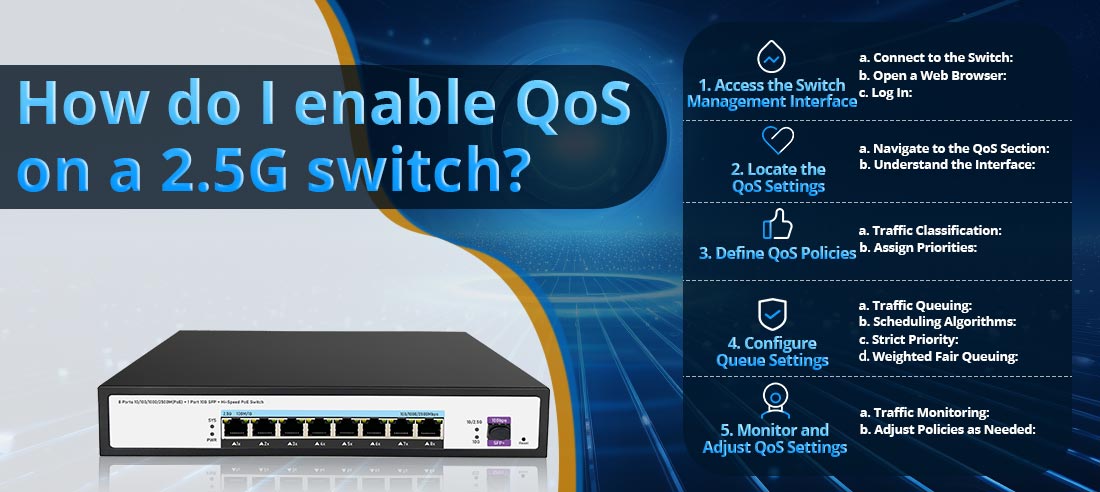
Enabling Quality of Service (QoS) on a 2.5G managed switch involves several steps to prioritize traffic effectively, ensuring that critical applications receive the necessary bandwidth. Here’s a detailed description of the process:
1. Access the Switch Management Interface
Connect to the Switch: Use an Ethernet cable to connect your computer to one of the switch’s management ports.
Open a Web Browser: Enter the IP address of the switch in the address bar. This IP is often provided in the switch’s manual.
Log In: Enter the administrator username and password. Default credentials can usually be found in the documentation, but it's essential to change them for security.
2. Locate the QoS Settings
Navigate to the QoS Section: Once logged in, look for a menu option labeled "QoS," "Traffic Management," or similar. This could be under the "Advanced Settings" or "Network Settings" section, depending on the switch model.
Understand the Interface: Familiarize yourself with the layout of the QoS settings, which typically include options for traffic classification, prioritization, and scheduling.
3. Define QoS Policies
Traffic Classification: This is where you define how the switch will identify different types of traffic. You may have options to classify based on:
--- Port Number: Specify which ports correspond to which types of traffic (e.g., VoIP on ports used by VoIP phones).
--- IP Address or Subnet: Identify traffic from specific devices or networks.
--- Protocol Type: Differentiate between protocols (e.g., HTTP, FTP, VoIP).
Assign Priorities: Assign priority levels to different traffic types, often ranging from low (e.g., background downloads) to high (e.g., VoIP calls). This is typically done using priority values (e.g., 0-7 in 802.1p):
--- High Priority: For time-sensitive applications like VoIP and video conferencing.
--- Medium Priority: For general business applications.
--- Low Priority: For non-critical traffic, such as file downloads or updates.
4. Configure Queue Settings
Traffic Queuing: Set up queues for different traffic classes. Each queue can be configured to handle a specific amount of bandwidth and can have different scheduling algorithms (e.g., weighted fair queuing or strict priority).
Scheduling Algorithms: Choose how packets will be forwarded from these queues. For example:
Strict Priority: Ensures that high-priority packets are sent first.
Weighted Fair Queuing: Allocates bandwidth fairly among all queues based on assigned weights.
5. Apply Settings
--- After configuring your policies and queue settings, save the changes. There may be an "Apply" or "Save" button at the bottom of the QoS settings page.
--- Some switches may require a reboot for changes to take effect. If prompted, confirm to reboot the switch.
6. Monitor and Adjust QoS Settings
Traffic Monitoring: After enabling QoS, use the switch’s monitoring tools to observe traffic patterns and ensure that prioritization is working as intended. This can usually be found in the “Status” or “Monitoring” section of the management interface.
Adjust Policies as Needed: Based on observed performance, you may need to refine your QoS settings, adjusting priority levels or adding/removing classifications to optimize performance further.
7. Documentation and Support
--- Refer to the specific user manual for your switch model for detailed instructions tailored to your device, as interfaces and options can vary significantly between manufacturers.
--- If you encounter issues, check for online resources or forums related to your switch model for additional troubleshooting tips.
Conclusion:
Enabling QoS on a 2.5G managed switch allows you to effectively prioritize network traffic, ensuring that critical applications receive the bandwidth they need for optimal performance. By carefully defining traffic classifications, assigning priorities, configuring queuing settings, and regularly monitoring performance, you can maintain a high-quality network experience even during peak usage times.